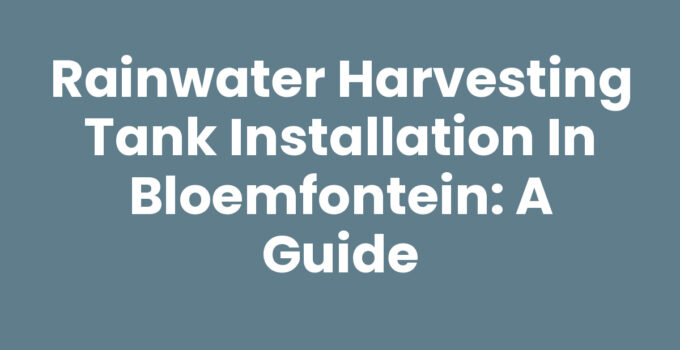As the world moves toward more sustainable living practices, rainwater harvesting has become a pivotal topic, especially in arid regions like Bloemfontein. This practice involves collecting and storing rainwater for future use, which can significantly reduce water bills and ensure a reliable water supply during dry seasons. In this guide, we will explore everything you need to know about rainwater harvesting tank installation in Bloemfontein, providing you with insightful tips and valuable information to facilitate your journey toward sustainable living.
Rainwater Harvesting Tank Installation in Bloemfontein: A Step-by-Step Guide
Installing a rainwater harvesting tank may seem daunting, but with the right guidance, it can be a manageable project. Here’s how you can go about it:
1. Planning & Sizing the System
The first step in your installation process is to plan. Assess your water needs and the catchment area available for rainwater collection. Consider the average rainfall in Bloemfontein, which is about 500mm per year. A general rule of thumb is that each square meter of roof can collect about 0.6 liters of water per mm of rain. With these metrics, determine how large your storage tank should be. This might involve consulting a professional to accurately estimate the size based on your household usage.
2. Choosing the Right Tank
Select a rainwater tank that suits your needs. Tanks come in various materials including plastic, concrete, and metal. Each has its own benefits and drawbacks. Plastic tanks are lightweight and resistant to rust, making them ideal for residential areas. Concrete tanks are sturdy and can hold larger volumes but are more prone to cracking. Choose a tank that fits both your budget and space.
3. Locating the Tank
Choose a location for your tank that is close to your house for easy access but also far enough from trees and shrubs that may drop organic material into the tank. Ensure that you’ve got adequate drainage around the tank location to prevent water pooling during heavy rains. Excavating a shallow trench for the tank can provide additional drainage.
4. Installing Gutters and Downspouts
Your rainwater harvesting system will need gutters and downspouts to transport the rainwater from your roof to your storage tank. Install gutters along the roofline, ensuring they slope toward the downspouts. Utilize debris filters to prevent leaves and other materials from clogging the system, and ensure your downspouts direct the water into the tank without spillage.
5. Connecting the Tank
As you move to connect your rainwater tank, ensure you install an inlet pipe from the downspout to the tank. Depending on your specific setup, you might also need an overflow pipe or hole to allow excess water to exit in case the tank is full, preventing overflow and potential damage.
6. Filtration and First Flush System
To maintain the quality of your harvested rainwater, install a filtration system. A first flush diverter is also recommended, which diverts the initial dirty rainwater away from your tank, ensuring that the cleaner runoff collects in your storage. This step is crucial for ensuring that your stored water remains clean and suitable for irrigation or non-potable uses.
7. Maintenance
Regular maintenance is vital for the longevity of your system. Clean the gutters and filters periodically to prevent blockages. Regularly inspect the tank for cracks or leaks and ensure that all parts are functioning correctly.
Benefits of Rainwater Harvesting in Bloemfontein
By installing a rainwater harvesting tank, you can enjoy numerous benefits:
- Cost Savings: Utilizing harvested rainwater for irrigation and toilet flushing can significantly reduce your monthly water bill.
- Environmental Impact: Conserving water helps to reduce your carbon footprint and promotes sustainable living practices.
- Resource Security: Harvesting rainwater ensures a reliable water source during droughts or water restrictions.
Important Considerations Before Installation
Before starting your rainwater harvesting tank installation, consider factors such as local regulations regarding water storage and whether you need permits for installation. It is also crucial to evaluate your property’s landscape and drainage. Consider doing a professional water audit for recommendations tailored to your specific situation.
In conclusion, rainwater harvesting tank installation in Bloemfontein is a rewarding endeavor that contributes to both cost-efficiency and sustainability. By following the guidelines detailed above, you can ensure a successful installation that benefits both your household and the environment.
Frequently Asked Questions
What types of rainwater harvesting tanks are available?
There are mainly plastic, concrete, and metal tanks, each with unique features and benefits.
Do I need any permits for rainwater harvesting in Bloemfontein?
Check with local regulations to determine if permits are necessary for your rainwater harvesting system.
How can I maintain my rainwater harvesting tank?
Regularly clean your gutters, inspect the tank for leaks, and ensure filtration systems are functioning properly.



